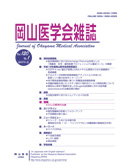

Journal of Okayama Medical Association
Published by Okayama Medical Association<Availability>
Full-text articles are available 3 years after publication.
Permalink : https://ousar.lib.okayama-u.ac.jp/14579
肝循環動態に関する研究 第2編 肝リンパに関する研究-実験犬による検討
Hashimoto, Hiroyuki
Published Date
1966-03-30
Abstract
To study dynamics and physico-chemical properties of the hepatic lymph of normal dogs, cannulation of hepatic lymph duct was performed under nembutal anesthesia, and the lymph flowing out of the fistula was continuously collected. Similar experiments were also carried out on dogs with acute carbon tetrachloride poisoning.
The results were as follows.
1. The average rate of hepatic lymph flow was 1.52cc per 10 minutes (0.07cc per 10 minutes per kilogram) in normal mongrel dogs.
2. In dogs with acute carbon tetrachloride poisoning, not only the average rate of hepatic lymph flow but also the pressure and the diameter of lymphatic vessels of the liver was remarkably increased.
3. More or less cellular elements, mainly lymphocytes, even some red blood cells, were detected in the liver lymph of intact dogs. A marked increase of red blood cells were observed in the lymph of dogs with acute carbon tetrachloride poisoning.
This fact indicated that the lymph-canaliculus of the liver was open to red blood corpuscles in part, and this phenomenon was manifested by carbon tetrachloride poisoning.
4. The liver lymph contained approximately similar amount of protein to the serum and all the protein fractions as observed in the serum. The A/G quotient was usually higher in the liver lymph than in the serum. These data would suggest that all fractions of seum protein are able to leak out from the sinusoid walls and enter the lymphatic system of the liver. Furthermore, albumin produced by the hepatic cells may directly enter this lymphatic system.
5. The hepatic lymph contained a greater amount of glucose than serum, whereas the amount of bilirubin, cholesterol and alkaline phosphatase in hepatic lymph was smaller than that in serum.
The results are of interest when the transfer of metabolites between hepatic cells and lymph or blood is considered.
Note
学位番号 甲第188号
ISSN
0030-1558
NCID
AN00032489
